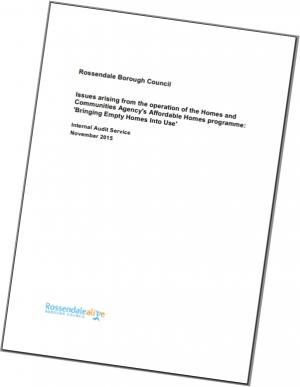



The report prepared by Lancashire County Council's Internal Audit Team into the Rossendale/PLACE Empty Homes Project reveals an extraordinary number of flaws in basic processes of management and procurement associated with the HCA-funded scheme.
Background
Problems with the Empty Homes Project emerged in spectacular style when the private sector contractor with responsibilty for nearly all aspects of delivery went into liquidation in February 2015, leaving Rossendale with numerous half-completed, unoccupied and in some cases untenantable properties to deal with. The financial liabilities of the Council are still uncertain but look to run to several hundreds of thousand pounds.
The "Empty Homes Project" was fronted by Rossendale on behalf of the PLACE consortium of five Pennine Lancashire councils. These are councils (the other four being Hyndburn, Pendle, Burnley, and Blackburn with Darwen) with some of the most challenging empty homes issues in the country. The consortium also included at least two housing associations; but it was Rossendale Borough Council that took easily the lion's share of the burden of delivery on behalf of all the five councils and the consortium as a whole. It seems that the liability of the other four councils is the subject of some ongoing discussion, but reading between the lines, the evidence offered in the report seems to suggest that Rossendale failed to create any contractual obligations that it can fall back on and will have to bear any financial losses itself.
The Empty Homes Programme
The hugely ambitious bid for HCA Empty Homes Programme funding was the second largest in the country behind that of the Greater Manchester Consortium, reflecting in part the extent of the empty homes issue in this part of the country. The first round bid was for £4.8million, representing 474 units in a mixture of Purchase and Repair and leased properties. The bid was subsequently rejigged to include a Revolving Loan component, apparently dreamt up by AAAW Ltd. Whatever teething problems may have existed, they did not diminish Rossendale's appetite, as a later, Round 2 bid was also successful. However, this seems subsequently to have been subsumed back into the under-performing Round 1 bid - as were several other Round 2 bids elsewhere: at least it does not feature in the details of the HCA programme as it stood at 31st March 2014 in a list obtained by EHN in July of that year.
What went wrong
The report provides a summary of the issues uncovered, which reads as follows:
- No assessment was made of the risks and appropriate controls in taking up the funding stream from the HCA and operating the programme within the council and across Pennine Lancashire.
- Normal management controls, expected procedures and statutory requirements were over-looked or over-ridden almost entirely.
- Other than the decision to act as accountable body for the funding, no decisions at all relating to this programme were made by elected members and no information was provided to them.
- Insufficient input was sought from the council's legal and financial statutory officers who were therefore only tangentially involved in and aware of the programme, and insufficient attention was given to detailed financial and legal matters.
- There was inadequate understanding of the funding programme and the way it was operated by the council's contractor.
- The way the programme was implemented and its targets were achieved changed significantly over time.
- The contractor was poorly commissioned and inadequately procured by the council. An inadequately skilled contractor was appointed who failed to deliver the council's unspecified requirements, but who instead incurred considerable liabilities on the council's behalf.
- The contractor's work was not directed effectively and was inadequately monitored by the council, and payments have been made in ways that were not agreed and not transparent, for work that does not appear to have been done, or completed to adequate standards.
- All the warning signs regarding the design of the funding stream and its operation in practice, including a number of external experts' advice and guidance, were ignored.
- There was inadequate supervision of a single council officer who was effectively made responsible for the management of the entire programme and given the scope to act in whatever way they felt was appropriate.
- The officer involved appears to have acted with good intentions, but with poor direction and inappropriate objectives that over-rode the council's other broader objectives.
- The single private sector contractor, AAAW Ltd, chosen by Rossendale to deliver the leasing component of the massive 474-home project is described in the report as having "no effective expertise in property renovation and management".
- The initial leases were entered into directly by AAAW Ltd. even though they were not a registered provider and were thus clearly unable to meet HCA grant requirements.
- Subsequently, Rossendale took on the leases, but AAAW Ltd issued tenancies in their own name despite having no interest in the properties.
